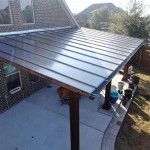How To Seal Outdoor Concrete Patio Paintings
Painting a concrete patio can transform a dull, gray slab into a vibrant and inviting outdoor space. However, unprotected outdoor concrete paintings are vulnerable to the elements, including UV radiation, rain, temperature fluctuations, and abrasion. Sealing the painted surface is crucial to ensuring the longevity and vibrancy of the artwork. Effective sealing protects the paint from fading, chipping, peeling, and damage caused by moisture and foot traffic. This article provides a comprehensive guide on how to properly seal outdoor concrete patio paintings, covering preparation, sealant selection, application techniques, and maintenance.
Preparing the Painted Surface
Proper preparation is paramount for achieving a durable and long-lasting seal. This involves thoroughly cleaning the painted surface and addressing any existing issues before applying the sealant. Failing to adequately prepare the surface can result in poor adhesion, premature sealant failure, and ultimately, damage to the underlying paint.
Cleaning the Painted Surface: Begin by removing all loose debris, dirt, and dust from the painted patio. A stiff-bristled brush or broom is effective for this initial cleaning. Next, wash the surface with a mild detergent solution. Avoid using harsh chemicals or abrasive cleaners, as these can damage the paint. Scrub the entire painted area thoroughly, paying particular attention to areas with stubborn stains or dirt buildup. Rinse the surface thoroughly with clean water to remove all traces of the detergent. Allow the painted surface to dry completely before proceeding. This may take several hours or even a full day, depending on weather conditions.
Addressing Existing Paint Issues: Inspect the painted surface for any signs of damage, such as chipping, peeling, or flaking paint. If any of these issues are present, they must be addressed before applying the sealant. Loose or flaking paint should be carefully removed using a scraper or wire brush. Feather the edges of the remaining paint to create a smooth transition. For minor chips or cracks, consider using a concrete patch compound to fill in the imperfections. Allow the patch compound to dry completely according to the manufacturer's instructions. Once the patch compound is dry, sand it smooth to blend seamlessly with the surrounding painted surface. Clean the patched areas thoroughly before proceeding.
Ensuring a Dry Surface: Moisture trapped beneath the sealant can lead to blistering, peeling, and other issues. It is critical to ensure that the painted surface is completely dry before applying the sealant. Use a moisture meter to verify the moisture content of the concrete. The acceptable moisture level will vary depending on the type of sealant being used, so consult the manufacturer's recommendations. If a moisture meter is not available, a simple test can be performed. Tape a clear plastic sheet to the painted surface and leave it in place for 24 hours. If moisture forms under the plastic sheet, the concrete is not dry enough to be sealed. Allow additional drying time and repeat the test until no moisture forms.
Selecting the Appropriate Sealant
Choosing the right sealant is crucial for protecting the painted concrete patio. Different sealants offer varying levels of protection, durability, and aesthetic qualities. Consider factors such as the type of paint used, the level of foot traffic the patio receives, and the desired finish when selecting a sealant.
Types of Sealants: Several types of sealants are suitable for outdoor concrete patio paintings, each with its own advantages and disadvantages.
Acrylic Sealants: Acrylic sealants are a popular choice for their affordability and ease of application. They provide good protection against UV radiation and water damage. However, acrylic sealants are generally less durable than other types of sealants and may require more frequent reapplication. They are also less resistant to abrasion and chemicals.
Polyurethane Sealants: Polyurethane sealants offer excellent durability and resistance to abrasion, chemicals, and UV radiation. They are a good choice for high-traffic areas. Polyurethane sealants are typically more expensive than acrylic sealants and may be more challenging to apply. They also tend to yellow over time, which may affect the appearance of the painted surface.
Epoxy Sealants: Epoxy sealants are known for their exceptional hardness and chemical resistance. They provide excellent protection against staining and abrasion. Epoxy sealants are often used in commercial or industrial settings. They can be more difficult to apply than other types of sealants and may require specialized equipment. They also tend to be more expensive and are generally not UV resistant, requiring a topcoat to protect them from the sun's rays.
Penetrating Sealants: Penetrating sealants, also known as silane or siloxane sealants, penetrate the concrete surface and create a hydrophobic barrier. They do not form a film on the surface, so they do not alter the appearance of the painted concrete. Penetrating sealants are a good choice for protecting against water damage and freeze-thaw cycles. However, they offer limited protection against abrasion and UV radiation.
Compatibility with Paint: It is essential to choose a sealant that is compatible with the type of paint used on the patio. Some sealants may react negatively with certain types of paint, causing discoloration, blistering, or peeling. Consult the manufacturer's recommendations for both the paint and the sealant to ensure compatibility. It is advisable to test the sealant on a small, inconspicuous area of the painted patio before applying it to the entire surface.
Desired Finish: Sealants are available in a variety of finishes, including matte, satin, and gloss. The desired finish will depend on the aesthetic preferences and the overall design of the outdoor space. Matte finishes provide a natural, non-reflective look. Satin finishes offer a subtle sheen. Gloss finishes provide a high-shine, reflective look. Consider how the finish will complement the painted artwork and the surrounding environment when making a selection.
Applying the Sealant
Proper application techniques are crucial for achieving a uniform and durable seal. This involves selecting the appropriate application method, applying the sealant in thin, even coats, and following the manufacturer's instructions regarding drying times and application temperature.
Application Methods: Several methods can be used to apply sealant to a concrete patio painting, including brushing, rolling, and spraying.
Brushing: Brushing is a good option for small areas or intricate designs. Use a high-quality brush with synthetic bristles to apply the sealant evenly. Apply the sealant in smooth, overlapping strokes, following the direction of the paint strokes. Be careful to avoid creating brush marks.
Rolling: Rolling is a more efficient method for covering large areas. Use a roller with a short nap to apply the sealant evenly. Apply the sealant in overlapping strokes, maintaining a wet edge to prevent lap marks. Avoid applying too much pressure, as this can cause the sealant to sag or drip.
Spraying: Spraying provides the most even and consistent coverage. Use an airless sprayer with a fine-finish tip to apply the sealant. Hold the sprayer at a consistent distance from the surface and move it in smooth, overlapping strokes. Avoid applying too much sealant in one area, as this can cause runs or drips. Proper safety measures, including wearing a respirator and eye protection, are essential when spraying sealants.
Applying Thin, Even Coats: Apply the sealant in thin, even coats. Multiple thin coats are preferable to one thick coat. Thin coats dry more quickly and are less likely to sag, drip, or form bubbles. Allow each coat to dry completely before applying the next coat. Follow the manufacturer's recommendations regarding drying times.
Following Manufacturer's Instructions: Always follow the manufacturer's instructions regarding application temperature, drying times, and number of coats required. Applying the sealant outside of the recommended temperature range can affect its performance and durability. Allow the sealant to dry completely before allowing foot traffic on the patio. Protect the sealed surface from rain or other moisture during the drying process. Consider applying the sealant in the early morning or late afternoon to avoid direct sunlight, which can cause the sealant to dry too quickly.
Maintaining the Sealed Surface
Regular maintenance is essential for prolonging the life of the sealed concrete patio painting. This involves cleaning the surface regularly, addressing any minor damage promptly, and reapplying the sealant as needed.
Regular Cleaning: Clean the sealed patio regularly with a mild detergent solution and water. Avoid using harsh chemicals or abrasive cleaners, as these can damage the sealant. Sweep or vacuum the surface regularly to remove dirt and debris. Pressure washing can be used to remove stubborn stains, but use caution and avoid using excessive pressure, which can damage the sealant or the underlying paint.
Addressing Damage Promptly: Inspect the sealed surface regularly for any signs of damage, such as cracks, chips, or peeling. Address any minor damage promptly to prevent it from worsening. Use a concrete patch compound to repair cracks or chips. Reapply sealant to the repaired areas to protect them from the elements.
Reapplication Schedule: The frequency of sealant reapplication will depend on the type of sealant used, the level of foot traffic the patio receives, and the severity of the weather conditions. Acrylic sealants typically require reapplication every one to two years. Polyurethane sealants may last for three to five years. Penetrating sealants may last for five to ten years. Inspect the sealed surface regularly and reapply the sealant when it begins to show signs of wear or damage. Before reapplying the sealant, clean the surface thoroughly and address any existing damage.
By following these guidelines, property owners can effectively seal outdoor concrete patio paintings, protecting their artistic investment from the elements and ensuring years of enjoyment.

Painting A Concrete Patio Step By Supershade South

The Solution To Decorating Concrete Patios Porches

How To Repaint A Painted Concrete Porch Cuckoo4design

Tips For Painting A Textured Concrete Patio

How To Repaint A Painted Concrete Porch Cuckoo4design

Before And After Painted Concrete Patio Thistlewood Farm

How To Paint And Seal Your Concrete Driveway Like New Pro Diy
Diy Tutorial Painting A Porch Or Patio With Painted Rug

Painted Concrete Slab And Brick Pavers One Year Later Jamie Lundstrom

How To Paint A Concrete Patio Love Renovations
Related Posts








